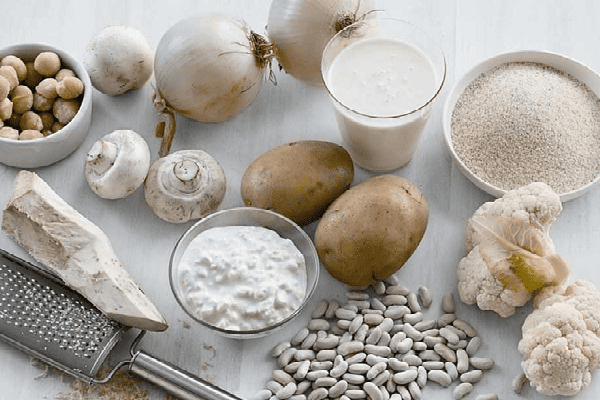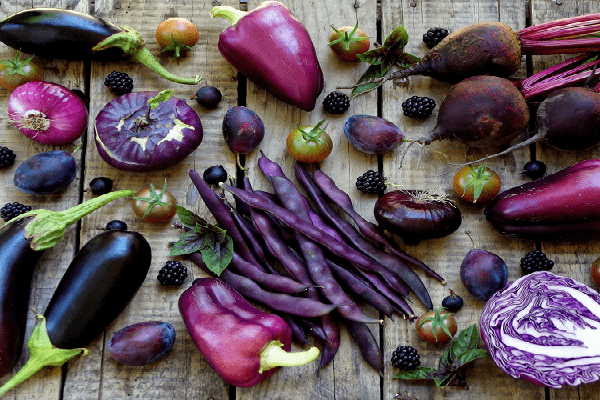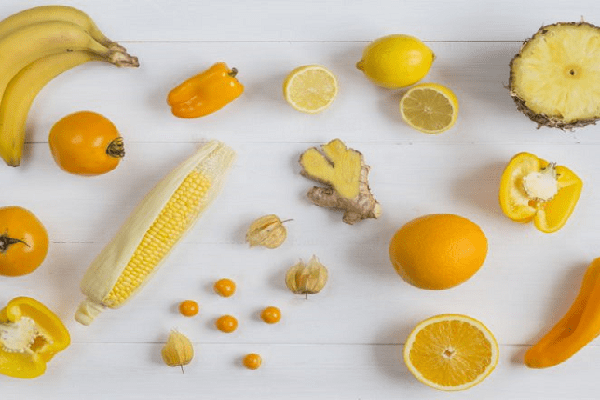Interesting diets >>>> Diet by food color
Diet by food color.

Some diets are striking in their ease of execution and the high degree of pleasure obtained from adhering to the diet. These diets include a "color diet" or a diet based on the color of foods.
The simplicity and affordability of the diet is determined by the freedom of choice of food in the diet, which is limited only by the color range. One day - one color.
It is worth taking into account that for people prone to allergies to red and orange fruits, berries and vegetables, you will have to do without some of the colors of the entire diet palette.
You can "keep" a diet by color indefinitely - until you get tired of this fun with colored food. But the effectiveness of the diet in terms of color is not inferior to other types of diets, especially when it comes to balanced nutrition and fortified food, as well as the treatment of the gastrointestinal tract and bringing body weight back to normal.
Diet by color can’t be called low-calorie. Rather, it is a diet based on natural products, since it is their natural shade that will be the criterion for selecting a product in the daily menu.
Color in nature is determined by biological pigments, which are chemical compounds with different characteristics. Of interest for nutrition are those pigments that are biologically active substances that have biochemical value for the human body. Those natural colors of plant food, which range from pale yellow, bright yellow, orange to red, purple, violet, blue and brown, are characteristic of carotenoids, quinones and flavonoids. These chemicals correspond to vitamin A (red, orange, bright yellow, bright brown), antioxidants - flavonoids (all shades of red, yellow, orange, blue, purple, lilac up to black) and tannins (white, light yellow, shades of brown). Burgundy, purple and brown hues also give green leaves a high iodine content in plants (which is typical for lettuce and algae). The chlorophyll color of the green parts of plants also determines their composition - the presence of a high amount of magnesium.
For animal products, coloring in red and orange shades indicates a high content of hemoglobin and bilirubin (this is iron). Fish and seafood have a specific red or orange color of soft tissues due to feeding on plant plankton with a corresponding shade (orange, red, burgundy, purple - gives a reddish appearance to tissues, colorless and green - does not stain tissues). So shrimp meat or fish meat can be turned into brightly colored lilac, pinkish, reddish shades just by introducing food of the appropriate color into the diet of these living organisms.
Based on the chemical characteristics of color pigments and their degree of usefulness for the body, we can say that the color scale indicates the presence in plant tissues of a sufficient amount of certain substances (vitamins or trace elements), which play an important role in the metabolic reactions of the human body.
The colors of the days of the diet can be arbitrarily arranged and even correlated with your mood, which is why the diet is good in terms of the color of the products - it corrects not only the figure and metabolism, but also corrects the psychological state of a person, because nothing changes a person's mood like the color of life.
In addition to all the other advantages, a diet in terms of food color will fundamentally broaden the horizons regarding the variety of food products - after all, you will have to look for products of a certain color in stores and at the bazaar, which, perhaps, a person had never used in nutrition before that time, since he did not know about them. existence in principle. This will benefit people who suffer from asceticism in food, and do not notice the monotony of their food.
The most unpleasant day in the diet is “colorless”. Usually it is left on the last day of the week, but it is more productive to spend such a food day on Thursday, otherwise the day off before the first working day will be boring. There are not so many colorless products, so that the basis of the diet will be drinking water in unlimited quantities, white tea. You can eat soup (chicken, fish or vegetable broth) with rice or pearl barley, boiled white onions (onion soup), white cabbage (cabbage soup), turyu (water plus bread) or other food products that become colorless when cooked. For a colorless day, jelly from oatmeal or rice flakes is suitable. A colorless day can be garnished with rice noodles, peeled rice, or tapioca. Boiled mussels can act as a "meat" dish, boiled white fish fillets or white fish fillets hot or cold smoked, boiled or fried squid or oyster meat. Particular caviar of fish (Pollock, Pike) is suitable for eating on this day. In general, all products with a hint of colorless transparency can become ingredients of the “colorless day” diet.

White color in dietary food is the color of dairy and sour milk products, cheeses (Suluguni, goat, Mozzarella, Munster, Tofu, Adyghe, Feta, Brie, Brynza), porridge (semolina), pasta and other flour products made from white flour, egg protein, all white fruits (bananas, coconut, Langsat (Dooku), Rambutan, Pitaya, Pineberry (white strawberry, pineapple strawberry), White mulberry, Lychee (Chinese plum), Mangosteen, Cherimoya, Guanabana) and vegetables (white beans, soy , white potatoes, Jerusalem artichoke, white radish, daikon, radish, turnip, white cabbage, white carrot, celery root, white onion, cauliflower). This is the color of sunflower seeds, peanuts and cashews, the color of porcini mushrooms, champignons, white mushrooms and oyster mushrooms. It is also the color of white chocolate, milkshakes and creams, creamy ice cream and whipped cream, marshmallows and meringue.
The "red day" of the diet is a feast for the belly! This day can be timed to coincide with a weekend or a holiday, if such a day is suddenly planned during the diet period. You can eat "red" meat (that is, not poultry). But don't dream about strawberries and tomatoes all day long. Red products also include: red (burgundy) beets, red bell peppers, Tamarillo, Guava, Tangierin, red apples, red, pink or watermelon radishes, Tlandianta (red cucumber), pomegranate, dogwood, grapefruit, watermelon, red bananas, hawthorn , rose hips, red viburnum, cherries, red cherries, Cardinal grapes, red currants, cranberries, lingonberries, raspberries and similar vegetables and fruits. You can eat soups: tomato, red borsch, beetroot. A side dish can be red beans, red fermented rice.
The "orange day" of the diet can also be a weekend or a holiday. It is the color of oatmeal or wheat porridge, brown rice, dried pea or chickpea puree, porridge or lentil puree. This is the color of fruits (apricot, persimmon, papaya, kumquat, orange, tangerine, Sapodilla, Medlar, cloudberry) and vegetables (pumpkin, carrot, orange bell pepper). This is the color of red fish meat, red caviar (Pink salmon, Chum salmon, Trout, Sockeye salmon, Coho salmon), small caviar (flying fish, pike perch), shrimp, crayfish, lobsters. And also this is the color of most mushrooms - chanterelles, honey agarics, boletus, boletus and others.

The "yellow color" of the diet is millet or corn porridge, cornflakes, and boiled (canned) corn. These are fruits (yellow pears, peaches, nectarines, melon, Pepino (Melon pear), lemon, Kiwano (Horned melon), Mammeya, Mango, Carambola, Pineapple, Mafai (Burmese grapes), yellow apples, quince, yellow plum, Sweetie, White grapes) and vegetables (sweet potatoes, yellow bell peppers, yellow tomatoes, Pineapple physalis, yellow zucchini squash, ginger root). This is the color of chicken yolk, yellow cheeses (Edam, Cheddar, Swiss, Parmesan), ghee. You can add partial fish caviar (cod, capelin, bream) to the diet.

"Purple, lilac, brown or blue" (call it what you want) day of the diet is a day of exotic and interesting food combinations in food. Blue and purple cabbage varieties (lilac broccoli, all types of red cabbage) and various varieties of red onions (aka purple), mushrooms with a cap color that matches the listed shades, nuts (pecans, walnuts, hazel, Brazilian, cedar), vegetables ( eggplants, all varieties of "red" potatoes, purple carrots, black and purple tomatoes, plum physalis, lilac kohlrabi and lilac root celery, purple chard), fruits (kaimito (Chrysophyllum), all varieties of Black grapes, Black mulberries, blackberries, blueberries, figs, black plums), iodized lettuce greens (iodized lettuce, lettuce), seaweed with a high iodine content. Garnish can be black beans, buckwheat, brown rice (unpeeled), barley groats, buckwheat noodles. Mushroom or buckwheat soups are a healthy first course. Rye bread is an indispensable thing on this day of diet. Animal protein dishes can consist of different types of black caviar (Sturgeon, Sevruga, Sterlet) and blue cheese. Chocolate and cocoa are quite suitable for this diet day, as well as chocolate and coffee ice cream, cakes and pastries with dark cakes and filling of the corresponding color, chocolate and nut butter, Turkish delight and halva.
Green is the lightest color in the diet. This is the color of green peas and green beans, the color of pistachios and pumpkin seeds, the color of sprouted cereals, the color of green buckwheat, the color of cabbage (broccoli, Brussels sprouts, Savoyard, leafy, lettuce), the color of green algae, the color of pomelo, kiwi, feijoa, Green grapes , avocado, green physalis, green pears and apples, lime, green bell pepper, okra, zucchini and squash, asparagus and rhubarb, cucumbers and artichokes, green mushrooms. Leafy and spicy greens, stalks of celery and green chard may be present in this day's diet. Green sorrel and green onion soups are perfect as first courses.
Do not flatter yourself about food products colored in different colors with dyes (artificial or natural) - these products have nothing to do with a colored diet, for this reason they are not suitable for a diet: lilac cookies, yellow chips, red sausage and similar "colored" foods. But will do: red adjika; ketchups; red, purple, brown and orange preserves and jams; orange (brown) eggplant or squash caviar, halva of various shades, natural cereal flakes and similar products made from natural products by heat treatment (stewing, steaming, boiling, roasting, grilling) or by drying, drying, smoking.
The color diet does not mean eating all types of foods of the same color on a given day. If the diet is not designed for one week, then the diet can be changed according to the list of foods of the same color that were not yet present in the diet on other days of the corresponding color. This way you can taste many delicious foods that were not in the diet before.

Read

Read



























